
LAB 5 Introduction
Pelvic Limb Muscles:
Rump and Thigh
(Guide to the Dissection of the Dog, 8th ed., pp. 51-61)
CONTENTS:
Lab Objectives:
• Reflect skin from the left leg and left side of the trunk (leaving skin attached to genitalia and the anus).
• Identify regional deep fascia, particularly the thick thoracolumbar deep fascia, fascia lata, and crural fascia. Popliteal lymph nodes are embedded in loose areolar fascia caudal to the stifle (knee).
• Identify the three major muscles comprising the caudal thigh group (hamstring muscles):
- biceps femoris m. (covering a thin, narrow caudal crural abductor m.)
- caudofemoralis m. (cat muscle derived from biceps femoris, absent in the dog)
- semitendinosus m.
- semimembranosus m. (two parts distally)
• Identify four muscles comprising the medial thigh group:
- sartorius m. (cranial & caudal parts in dog vs cat)
- pectineus m.
- gracilis m.
- adductor m. (brevis & longus parts, more distinct in the cat)
(find the "femoral triangle", located between the sartorius m. and the pectineus m.)
• Identify four major muscles comprising lateral muscles of the pelvis:
- tensor fasciae latae m. (cranial & caudal parts particularly in the dog)
- superficial gluteal m.
- middle gluteal m. (a caudal, deep component is called the piriformis m.)
- deep gluteal m.
(also, in this or the next lab, find a surgical landmark: the articularis coxae m.)
Anatomical Terms:
Pelvic Limb: muscles & fascia:
superficial & deep gluteal fascia
sacrotuberous ligament (absent in cat)
thoracolumbar (deep) fascia
fascia lata
femoral triangle
popliteal lymph node [palpate]
Thigh Muscles
biceps femoris m.
(caudal crural abductor m.)
semitendinosus m. [palpate]
semimembranosus m. [palpate]
sartorius m. (cranial & caudal parts in the dog vs the cat)
gracilis m.
symphysial tendon
pectineus m.
adductor m. (adductor magus & longus parts more distinct in cat)
Rump Muscles
gluteofemoralis (caudofemoralis) m. (cat)
tensor fasciae latae m. (cranial & caudal parts esp. in the dog)
superficial gluteal m.
middle gluteal m.
piriformis m.
deep gluteal m.
articularis coxae m.
Note:
coxa [Latin] = hip (os coxae = bone of the hip)
poples [Latin] = ham (popliteal pertains to the knee)
pecten [Latin] = comb (pectineus m. = sharp-edged)
piram & forma [Latin] = pear & shape (piriformis m. -- misnamed)
sartorius [Latin] = of a tailor (sartorius m.; sartorial refers to garments)
Tailors use what muscle to cross their knees when they sew?
Instructor Commentary:
Major regions of the pelvic limb include: pelvic region (containing the os coxae bone), thigh (femur bone), crus (tibia and fibula bones), and pes (foot). The four regions are connected by three joints: hip (coxofemoral joint), stifle (knee); and tarsus (human ankle or quadruped hock).
The pelvic limb is designed for propulsion. The pelvis is firmly attached to the spine (sacroiliac joint) and the limb is longer and more angulated than the thoracic limb (which is designed to bear weight and absorb impact).
The cat is more flexible than the dog; and anatomically, the cat lacks ligaments found in the dog and other common domestic mammals. The cat does not have a suprapsinous ligament (along the tops of vertebral spines) or a nuchal ligament (in the neck). And, the cat lacks the sacrotuberous ligament encountered in this lab.
Because of the absence of a sacrotuberous ligament, proximal muscle fibers of the biceps femoris m. become a separate gluteofemoralis (caudofemoralis) m. in the cat (in the dog the proximal muscle fibers attach to the sacrotuberous ligament and remain with the biceps femoris m.).
Popliteal lymph nodes drain the crus and pes. They become enlarged when lymph flow through them is increased, such as during inflammation of the foot.
In preparation for this lab, identify prominent features of the os coxae and femur. Have the bones available in your lab coat pocket so you can examine them during the dissection.
Dissection Steps:
Click to view a PDF list of dissection procedures for this lab:
Show List of Dissection Steps (PDF)
Dissection Images:
Note: Click an image to see it enlarged, view its caption, and toggle its labels.
| 1 | 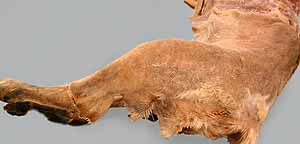 |
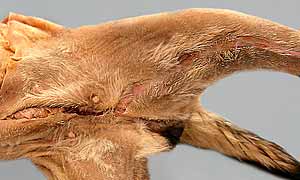 |
2 |
| 3 | 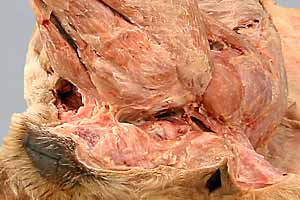 |
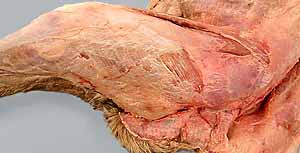 |
4 |
| 5 | 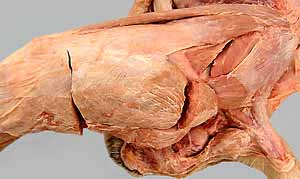 |
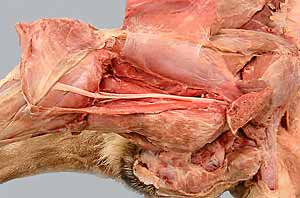 |
6 |
| 7 | 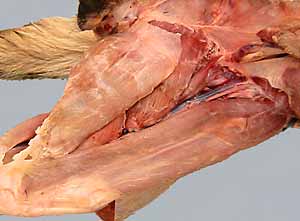 |
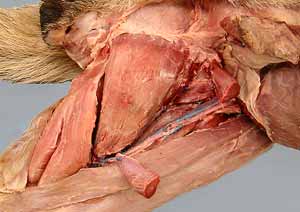 |
8 |
| 9 | 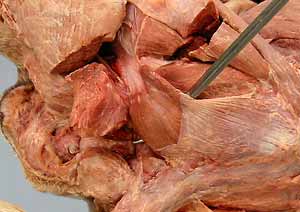 |
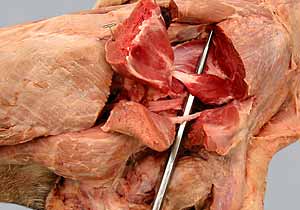 |
10 |
| 11 | 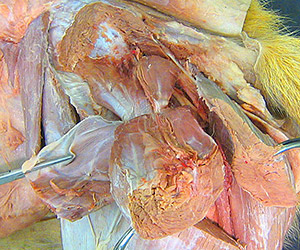 |
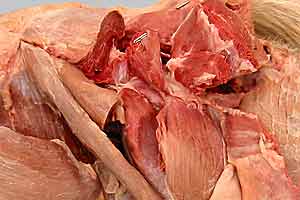 |
12 |
| 13 | 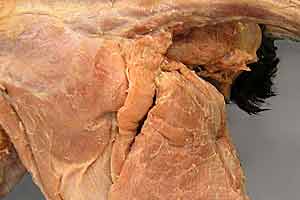 |
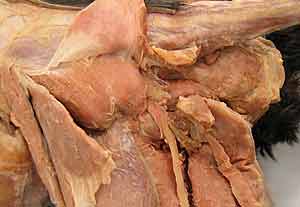 |
14 |
| 15 | 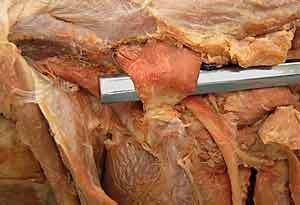 |
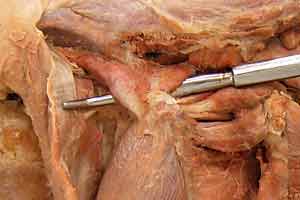 |
16 |